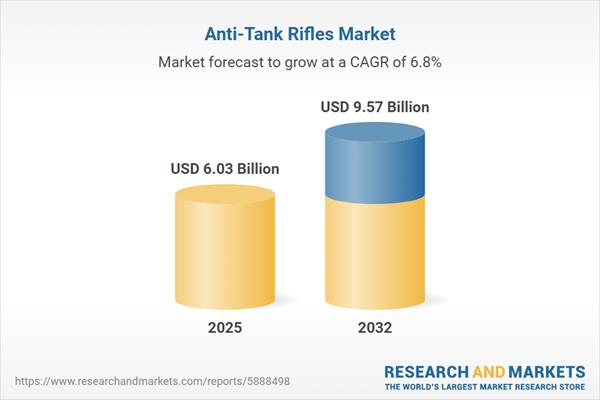Speak directly to the analyst to clarify any post sales queries you may have.
The anti-tank rifles market is evolving rapidly, driven by continuous advances in battlefield requirements, technology integration, and changing geopolitical landscapes. Senior leaders in defense, security, and procurement are seeking strategic insight into how these sophisticated systems are enabling operational flexibility and risk management in multidomain conflict environments.
Market Snapshot: Anti-Tank Rifles Market Growth and Trends
The anti-tank rifles market grew from USD 5.64 billion in 2024 to USD 6.03 billion in 2025. It is projected to expand at a CAGR of 6.81%, reaching USD 9.57 billion by 2032. Demand is being shaped by heightened investments in force modernization and innovative capability insertion programs as defense agencies seek solutions with precise anti-armor performance across varied theaters. Portability, integration into agile troop formations, and reduced logistical complexity are key purchasing drivers among military and security organizations globally.
Scope & Segmentation: Market Structure and Insights
The report provides a detailed analysis of the anti-tank rifles market across action types, calibers, end-users, propulsion technologies, regions, and leading participants.
- Action Types: Automatic (Gas Operated, Recoil Operated), Bolt Action (Straight Pull, Turn Bolt), Semi-Automatic (Gas Operated, Recoil Operated)
- Calibers: 12.7 Millimeter, 14.5 Millimeter, 20 Millimeter, Above 20 Millimeter (23, 25, and 30 Millimeter)
- End Users: Homeland Security, Law Enforcement, Military
- Technology: Caseless Propulsion (Metal Cased, Polymer Cased), Conventional Propulsion
- Regions Covered: Americas (North America, Latin America), Europe, Middle East & Africa, Asia-Pacific
- Companies Profiled: FN Herstal SA, Denel Land Systems (Pty) Ltd., Barrett Firearms Manufacturing, Inc., Accuracy International Ltd., McMillan Firearms Manufacturing, Inc., Desert Tactical Arms LLC, CheyTac LLC, Promtechnologia LLC, Steyr Mannlicher GmbH & Co KG, Oberland Arms GmbH
Key Takeaways: Strategic Insights for Senior Leaders
- Modern anti-tank rifles have transitioned to portable, precision platforms, supporting both conventional and asymmetrical mission requirements.
- Materials science breakthroughs are resulting in lighter systems with enhanced recoil management, increasing agility for infantry and special teams.
- Interoperability is rising through networked operations, integrating rifles with digital targeting systems and unmanned reconnaissance assets.
- Collaborative programs between contractors, defense labs, and academia are elevating innovation speed and improving operator performance in the field.
- Segmented demand is visible, with homeland security and law enforcement units adopting specialized platforms for perimeter and incident response roles, while military users focus on reliability in varied operational environments.
- Regional procurement priorities reflect diverse operational doctrines, with tailored solutions for mobility, cost-effectiveness, and standoff capabilities.
Tariff Impact: Navigating Policy Shifts and Supply Chains
Recent changes in United States tariff policy have altered the cost structure for critical inputs such as alloys and optics. This has led manufacturers to adapt sourcing strategies—including shifting assembly to allied markets and increasing vertical integration—to preserve both cost efficiencies and quality. These developments are influencing the composition of supplier networks and the global competitiveness of established manufacturers, prompting flexibility and proactive risk assessments in procurement.
Methodology & Data Sources: Rigorous Market Intelligence
This report combines primary research—including confidential interviews with procurement officers, technical experts, and field users—with a thorough secondary analysis of open-source publications, patents, and policy documents. Triangulation and statistical analyses ensure reliable findings and actionable intelligence calibrated for strategic decision-making.
Why This Report Matters: Decision Support for Stakeholders
- Enables procurement leaders to benchmark current capabilities and identify tactical gaps based on segmentation, regional trends, and user requirements.
- Delivers intelligence for aligning investments in modular design, digital integration, and strategic alliances to maximize system lifecycle value and operational resilience.
- Supports supply chain and policy analysts in evaluating the risks and opportunities associated with tariff policy shifts, sourcing, and global trade adjustments.
Conclusion
The anti-tank rifles market is undergoing significant transformation as leaders mobilize to address new operational and technical challenges. This analysis equips decision-makers to navigate emerging developments and optimize long-term market advantage.
Additional Product Information:
- Purchase of this report includes 1 year online access with quarterly updates.
- This report can be updated on request. Please contact our Customer Experience team using the Ask a Question widget on our website.
Table of Contents
3. Executive Summary
4. Market Overview
7. Cumulative Impact of Artificial Intelligence 2025
Companies Mentioned
The companies profiled in this Anti-Tank Rifles market report include:- FN Herstal SA
- Denel Land Systems (Pty) Ltd.
- Barrett Firearms Manufacturing, Inc.
- Accuracy International Ltd.
- McMillan Firearms Manufacturing, Inc.
- Desert Tactical Arms LLC
- CheyTac LLC
- Promtechnologia LLC
- Steyr Mannlicher GmbH & Co KG
- Oberland Arms GmbH
Table Information
| Report Attribute | Details |
|---|---|
| No. of Pages | 192 |
| Published | October 2025 |
| Forecast Period | 2025 - 2032 |
| Estimated Market Value ( USD | $ 6.03 Billion |
| Forecasted Market Value ( USD | $ 9.57 Billion |
| Compound Annual Growth Rate | 6.8% |
| Regions Covered | Global |
| No. of Companies Mentioned | 11 |









